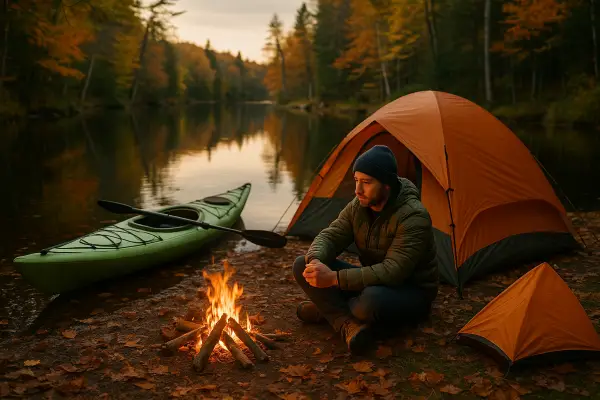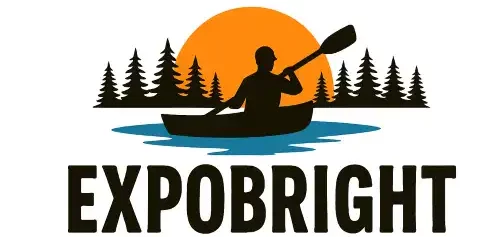New Hampshire’s pristine waters offer some of the most rewarding kayak camping experiences in New England, yet many paddlers struggle to find the right combination of stunning scenery and legal camping opportunities. The state’s complex mix of private land, state parks, and protected wilderness areas can make planning a multi-day paddle adventure feel overwhelming. So where can you kayak camp in New Hampshire?
During my years guiding trips through these waters, I’ve watched countless kayakers miss out on incredible overnight experiences simply because they didn’t know where to look. The key lies in understanding which waters offer legitimate camping access and how to navigate the regulations that protect these special places.
Where can you kayak camp in New Hampshire?
New Hampshire offers several excellent kayak camping destinations, with Lake Umbagog providing the premier wilderness experience through its 33 remote camping sites accessible only by boat. The Connecticut Lakes region in Pittsburg also delivers exceptional opportunities for multi-day paddling adventures.

Lake Umbagog: New Hampshire’s crown jewel for remote camping
Located in Coös County on the Maine border, Lake Umbagog stands as New Hampshire’s most significant destination for kayak camping. This shallow wilderness lake spans approximately 7,850 acres and features 33 camping locations that can only be reached by watercraft, making it a true backcountry experience.
The remote island sites, such as Site 32, offer complete solitude with amenities including fire grates, picnic tables, and large platform tent sites that can accommodate multiple tents. Most sites require a paddle of 2-4 miles from the boat launch, providing that perfect balance of accessibility and wilderness immersion. The lake’s relatively calm waters make it suitable for intermediate paddlers, though wind can create challenging conditions on larger sections.
Lake Umbagog National Wildlife Refuge encompasses much of the surrounding area, creating exceptional wildlife viewing opportunities. Bald eagles, osprey, moose, and loons are commonly spotted, particularly during early morning and evening paddles. The Northern Forest Canoe Trail passes through the area, offering an 8-10 mile route through the refuge that connects to the Androscoggin River.
Connecticut Lakes region: Pittsburg’s pristine waters
The Connecticut Lakes region in Pittsburg represents some of New Hampshire’s most remote and pristine paddling waters. This area includes Lake Francis, First Connecticut Lake, Second Connecticut Lake, and Third Connecticut Lake, forming the headwaters of the Connecticut River system.
Lake Francis State Park provides the primary camping base for this region, offering both drive-in and walk-in camping sites. From here, paddlers can access 2,082 acres of water with minimal boat traffic and stunning mountain vistas. The park serves as an excellent launching point for exploring the entire Connecticut Lakes chain.
First Connecticut Lake, at 2,807 acres, offers the largest paddling area in the region with multiple boat launches and relatively undeveloped shorelines. The lake provides excellent fishing for lake trout and landlocked salmon while maintaining that wilderness feel despite its size. Third Connecticut Lake, much smaller at 289 acres, delivers the most intimate paddling experience with virtually no development along its shores.
Camping in this region requires staying at designated campgrounds, as the surrounding private timber lands restrict camping elsewhere. However, the established campgrounds provide excellent access to multiple lakes, making it easy to explore different waters during a multi-day stay.
Androscoggin River: Moving water adventures
The Androscoggin River offers unique opportunities for river camping combined with kayaking. Originating in Errol, this river winds through several New Hampshire towns before entering Maine, providing varied experiences from gentle flatwater to challenging whitewater sections.
Several outfitters in the Errol area provide both equipment rentals and guided multi-day trips that include riverside camping. The river passes through diverse ecosystems, from deep forests to open meadows, offering excellent wildlife viewing opportunities including moose, eagles, and osprey.
The Thirteen Mile Woods section provides particularly scenic paddling with minimal development and good access to the surrounding White Mountain National Forest. While most camping requires using established campgrounds, the area offers numerous options for multi-day river expeditions.
Squam Lake and other scenic options
Squam Lake, famous as the filming location for “On Golden Pond,” provides more developed but equally beautiful kayak camping opportunities. While lacking the remote wilderness feel of Lake Umbagog, Squam offers numerous islands to explore and several campgrounds around its perimeter.
The lake’s 67 unnamed islands create endless exploration opportunities, and the clear waters provide excellent swimming and fishing. The more developed nature of the area means better access to supplies and services, making it ideal for families or those new to kayak camping.
Pawtuckaway State Park and developed options
For those seeking a gentler introduction to kayak camping, several state parks offer excellent opportunities with more amenities and easier access. Pawtuckaway State Park features a large lake with numerous islands and coves to explore, plus established camping facilities.
Wellington State Park on Newfound Lake provides another excellent option with crystal-clear waters and stunning mountain views. While these locations lack the remote wilderness experience of northern destinations, they offer reliable facilities and easier logistics for planning multi-day trips.
Essential regulations and requirements
New Hampshire requires all paddlers to carry Coast Guard-approved personal flotation devices for each person in the vessel. Children 12 and under must wear their life jackets at all times while on the water. Non-motorized kayaks and canoes don’t require registration, but any vessel with a motor, including electric trolling motors, must be registered with the state.
Camping regulations vary significantly by location. Lake Umbagog requires reservations through Reserve America, and sites often book months in advance for peak summer seasons. State parks have specific camping policies including a 14-day maximum stay limit and advance reservation requirements.
Backcountry camping rules apply in the White Mountain National Forest areas, requiring camping at least 200 feet from trails, streams, and other water sources. Fires are generally permitted below treeline but strongly discouraged to minimize environmental impact.
Planning your kayak camping adventure
Successful kayak camping in New Hampshire requires careful planning, especially for remote destinations like Lake Umbagog. Weather conditions can change rapidly, and early season trips may encounter ice even into May. Late September through early October offers spectacular fall foliage but requires preparation for cooler temperatures.
Water levels fluctuate seasonally, particularly on the Connecticut Lakes and Androscoggin River. Spring offers the highest water levels but also the most unpredictable weather. Summer provides the most stable conditions but also the highest number of other visitors.
Essential gear includes proper cold-water clothing systems, waterproof storage for overnight gear, and reliable navigation equipment. Many remote areas lack cell phone coverage, making emergency communication planning crucial for safety.
Conclusion
Three months ago, I returned from guiding a family through Lake Umbagog’s remote island sites, watching their excitement build as we paddled away from the last visible shoreline development into true wilderness. Their youngest daughter, initially nervous about sleeping on a remote island, spent the evening identifying bird calls while her parents rediscovered the peace that only comes from being genuinely disconnected from daily life. Following a comprehensive guide transforms uncertain paddlers into confident adventurers who can safely access New Hampshire’s most remarkable waterways, turning a potentially stressful expedition into the transformative experience that kayak camping should be.
